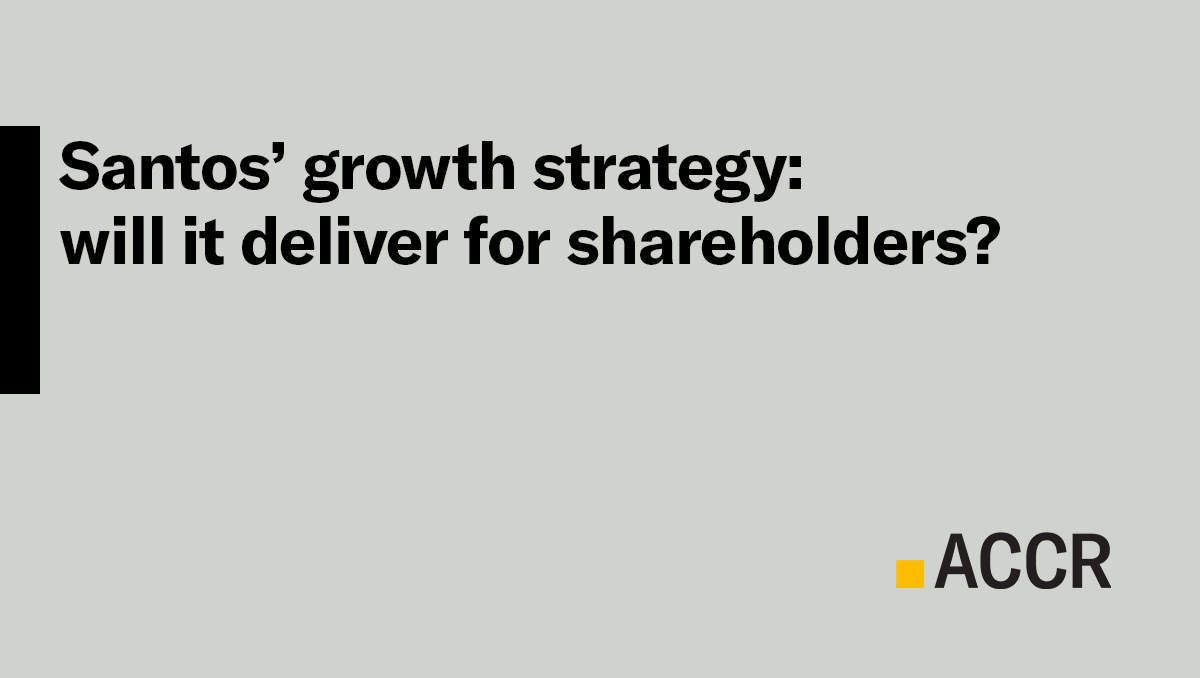Publication Santos’ growth strategy: will it deliver for shareholders?
Executive summary
Commencing with the Final Investment Decision for the Barossa project in late March 2021, Santos Ltd (Santos) departed from a low cost operating model (2016-2020) and pivoted to a growth phase, increasing capex by 142% (2021-2023). This period of growth has coincided with chronic share price underperformance relative to oil and gas peers - a source of frustration for shareholders and management alike.
"We're looking at every avenue to unlock shareholder value, we're very frustrated at our share price… it's stalled, and we need to unstall it."
Santos CEO, Kevin Gallagher, 2023 Investor Briefing Day.
This report examines if production growth is the optimum strategy for Santos’ investors, and if not, whether there is an alternate pathway to “unlock” shareholder value.
To assess this, ACCR undertook an asset-level, risk-adjusted financial analysis of Santos’ unsanctioned growth portfolio.[1] We selected for analysis all projects with a publicly stated target Final Investment Decision (FID) date, which includes the Narrabri gas, Papua LNG and Dorado oil projects.[2] We found these projects appear to generate modest value accretion for shareholders, face a host of challenges, and are sensitive to cost overruns.
Examining an alternative strategy to production growth, we found share buybacks appear to offer higher value than delivering the selected unsanctioned projects, with lower risk and fewer emissions - therefore better aligning with shareholder interests.
To test whether these projects are Paris-aligned, we undertook a global industry, least-cost evaluation of their alignment with the IEA’s NZE pathway. We found that none of the three are Paris-aligned, nor are they cost-competitive compared to other unapproved oil and gas projects.
While still operating a low-cost model in 2018, Santos’ CEO warned; “Our industry has got a habit of blowing themselves up when they go into growth mode.”[3] The strong conclusion from our analysis is that Santos’ current capex-heavy production growth strategy, in an industry that is in long-term structural decline, is not the optimal strategy to maximise shareholder returns.
Key findings
Santos’ current capex heavy, production growth strategy is not the optimal strategy to maximise shareholder returns.
The portfolio of oil and gas projects Santos is targeting for Final Investment Decision (FID) within the next two years appears to generate minimal value for shareholders.
A capital return strategy, i.e. share buybacks, offers higher value than delivering the portfolio of unsanctioned projects, with lower risk and fewer emissions.
- The total net present value (NPV) of the unsanctioned portfolio is a modest $803 million, equivalent to just 5% of Santos’ market capitalisation; forecast capex is over $6 billion. We estimate reallocating capital from these unsanctioned projects to share buybacks would generate an additional $730 million value. We estimate there’s an additional $1.7 billion upside available from ceasing fossil fuel developments because it would reduce costs and risk for the business.
The three projects up for imminent FID all face a range of risks, and the portfolio as a whole is sensitive to the kind of cost overruns typically seen in Australia’s LNG sector.
- Assuming a 20% capex overrun - with average exceedance of Australia’s LNG sector at 35% - a further $541 million of NPV would be eroded from the portfolio.
Based on a global industry, least-cost evaluation of alignment with the IEA’s NZE pathway, none of the projects are Paris-aligned or low-cost.
Analysis of 30 years of Santos’ shareholder returns shows production growth does not seem to have a positive correlation with shareholder returns.
Shareholder returns have been significantly stronger when Santos is operating under a low-cost operating model.
- In the low-cost operating phase (2016-2021), shareholder returns outperformed the MSCI World Energy Sector Index by 162%.
- In the current growth phase (2021-2023), capex more than doubled and returns lagged the MSCI World Energy Sector Index by 69%.
In 2023 Santos’ dividend and share buyback yield was 7.4%, well below the 11% average of a group of nine Australian and global peers.
Santos uses a higher medium term oil price assumption than any of the nine companies in this peer group - risking making unsanctioned projects appear more attractive.
View Santos’ growth strategy: will it deliver for shareholders? as a slide deck

Please read the terms and conditions attached to the use of this site.
Using Rystad raw data and ACCR analysis. Methodology, data and assumptions are in Appendix A. ↩︎
In order to avoid comment on potential issues in ACCR v Santos Ltd (NSD858/2021), we have limited the scope of the report to those unsanctioned projects where Santos has announced target FID dates by 2025. Project descriptions are in Appendix C. ↩︎
Santos CEO Kevin Gallagher, 2018 Investor Briefing Day. ↩︎
